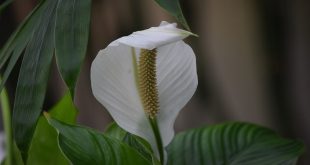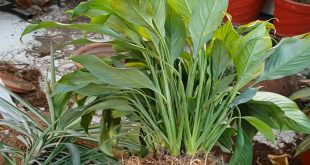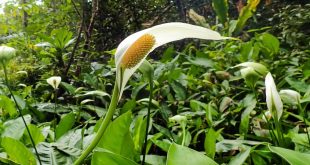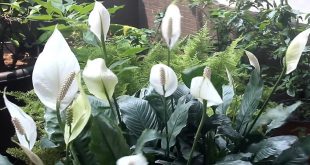Your peace lily leaves may be curling and drooping due to inadequate water or lighting conditions. This article will provide insights into the possible reasons behind this issue and offer tips on how to revive your peace lily’s health.
Peace lilies, scientifically known as spathiphyllum, are popular indoor plants due to their ability to purify the air and add beauty to any space. However, they can be sensitive to changes in their environment and require specific care. When peace lily leaves start to curl and droop, it is essential to identify the underlying cause and take appropriate action to restore their vitality.
By understanding the potential triggers and implementing proper care techniques, you can help your peace lily thrive and display its signature elegant foliage.
Understanding The Importance Of Leaf Health
Having a lush and healthy peace lily is not only a source of pride for plant owners, but it also contributes to a harmonious and calming atmosphere in any space. However, when the leaves of your peace lily start to curl and droop, it can be cause for concern.
Understanding the importance of leaf health is crucial to maintaining the overall vitality of your plant.
Why It’s Important To Keep An Eye On Your Peace Lily’s Leaves
Monitoring the condition of your peace lily’s leaves can provide valuable insights into its overall health and well-being. By observing any changes in leaf appearance, you can quickly identify and address any issues that may be affecting the plant. Neglecting leaf health can have negative consequences for the plant’s growth and overall appearance.
Signs Of Healthy Leaves And Their Contribution To Plant Vitality
Healthy leaves are an indication of a thriving peace lily. They play a vital role in the plant’s vitality and overall wellness. Here are some key signs to look out for:
- Vibrant green color: Healthy peace lily leaves should exhibit a rich, vibrant green hue. This indicates that the plant is receiving an adequate amount of light and nutrients.
- Good turgidity: Turgidity refers to the firmness and stiffness of the leaves. Healthy peace lily leaves should feel firm to the touch, indicating that they are properly hydrated.
- Upright posture: Well-maintained peace lilies display leaves that stand tall and upright. Drooping or wilted leaves can be a sign of watering issues or insufficient light.
- No spots or discoloration: Healthy leaves should be free from any blemishes, spots, or discoloration. Any such abnormalities may indicate the presence of pests, disease, or improper care.
By keeping a diligent eye on the condition of your peace lily’s leaves, you can ensure that it remains in optimal health, allowing it to thrive and beautify your surroundings. Remember to provide sufficient light, water, and care to maintain those vibrant green leaves that bring life and tranquility to your space.
Common Causes Of Curling And Drooping Leaves In Peace Lilies
Curling and drooping leaves in peace lilies can be a cause for concern, but understanding the common culprits behind this issue can help you take the necessary steps to restore your plant’s health. Overwatering and poor drainage are often to blame, as excessive moisture can lead to root rot and leaf wilting.
Similarly, insufficient watering or dry conditions can result in the same symptoms, as the plant struggles to absorb enough water to maintain its leaf health. Additionally, temperature extremes and improper humidity levels can impact the peace lily’s overall well-being, causing its leaves to curl and droop.
By addressing these factors, you can ensure your peace lily thrives and remains a beautiful addition to your indoor space.
Identifying And Addressing Overwatering Issues
Your peace lily is a stunning addition to your indoor space, with its elegant white blooms and lush green leaves. However, if you’ve noticed that the leaves are curling and drooping, it’s a sign that something isn’t quite right. Overwatering is one of the most common causes of this issue, and it’s important to understand its consequences and how to address it.
So, let’s dive into identifying and addressing overwatering issues.
Understanding The Consequences Of Overwatering On Peace Lily Leaves
- Overwatering leads to root rot, as excessive moisture suffocates the roots and prevents them from accessing oxygen. This causes the leaves to curl and droop.
- The excess water also disrupts the plant’s ability to take up nutrients, leading to yellowing, browning, or wilting of the leaves.
- Additionally, overwatering provides a favorable environment for fungal and bacterial growth, further damaging the leaves and overall health of the plant.
Assessing Soil Moisture Levels And Drainage
- Before watering your peace lily, check the moisture level of the soil by inserting your finger about an inch deep. If it feels moist, hold off on watering.
- Ensure that your pot has proper drainage holes to allow excess water to escape. Poor drainage can lead to waterlogging, causing the root rot and leaf issues we want to avoid.
Tips For Proper Watering Techniques And Avoiding Overwatering
- Water your peace lily only when the top inch of soil feels dry to the touch. This ensures that the roots receive adequate moisture without becoming waterlogged.
- Use room temperature water and pour it directly onto the soil, avoiding the leaves. Moisture on the leaves can encourage diseases and lead to leaf curling.
- Consider using a well-draining potting mix to help prevent water from collecting around the roots.
- If you accidentally overwater, allow the soil to dry out before watering again. This will give the roots a chance to recover.
By understanding the consequences of overwatering, assessing soil moisture levels, and adopting proper watering techniques, you can help your peace lily thrive. Remember, a little extra caution when it comes to watering can go a long way in keeping your peace lily’s leaves vibrant and healthy.
Addressing Underwatering And Dry Conditions To Revive Leaves
When it comes to caring for your peace lily, it’s crucial to pay attention to signs of underwatering. One of the most common indicators is when the leaves start to curl and droop. Understanding how to assess these signs is key to reviving your plant and promoting healthy growth.
So, let’s dive in and examine the manifestations of underwatering in peace lily leaves:
- Wilting and drooping: Underwatered peace lilies will exhibit wilting and drooping leaves. This is a defense mechanism in which the plant conserves moisture by reducing surface area exposure to sunlight.
- Yellowing or browning: As the lack of water persists, peace lily leaves may begin to turn yellow or brown. This occurs due to a reduction in chlorophyll production, which is necessary for photosynthesis.
- Curling and crispy edges: The leaves may curl and develop crispy edges as an attempt to minimize water loss through evaporation. This curling is also a response to insufficient water reaching the leaf tissues.
Strategies For Watering Frequency And Proper Hydration Levels
To address underwatering and revive your peace lily, it’s essential to implement proper watering techniques. Consider the following strategies to ensure your plant receives adequate hydration:
- Consistency is key: Develop a consistent watering routine to prevent periods of drought stress. Aim to water your peace lily about once a week, adjusting the frequency based on environmental conditions and the size of the pot.
- Test the soil: Before watering, check the moisture level in the soil by inserting your finger about an inch deep. If it feels dry, it’s time to water the plant. However, if it feels moist or wet, hold off on watering until the soil becomes slightly dry.
- Drainage is essential: Ensure your peace lily is planted in a pot with proper drainage holes. Excess water should freely drain out to prevent root rot, which can occur when the roots sit in stagnant water.
- Water thoroughly: When you water, be sure to thoroughly saturate the soil until water drains through the bottom of the pot. This ensures the roots receive sufficient moisture throughout the entire root ball.
Information On Humidity Requirements And Ways To Increase Moisture
Along with proper watering, maintaining the appropriate humidity level is crucial for the well-being of your peace lily. Follow these tips to provide the ideal conditions for your plant:
- Ideal humidity: Peace lilies prefer high humidity levels, around 40-60%. Dry indoor environments, particularly during winter months, can lead to stress and leaf issues.
- Humidity boosters: There are several ways to increase humidity around your peace lily. Consider these options:
- Grouping plants together: Placing multiple plants in close proximity helps create a microclimate with elevated humidity levels.
- Use a humidity tray: Set your peace lily on a shallow tray filled with water and pebbles. As the water evaporates, it increases the surrounding humidity.
- Mist your plant: Use a spray bottle to mist the leaves of your peace lily regularly. This simulates a humid environment and helps prevent leaf dehydration.
- Consider a humidifier: If you have multiple indoor plants or struggle to maintain humidity levels, investing in a humidifier can provide consistent moisture in the air.
By addressing any underwatering issues and ensuring proper hydration and humidity for your peace lily, you can rejuvenate its leaves and create an optimal environment for growth. Remember to stay consistent in your watering routine and monitor your plant’s response to make adjustments as necessary.
Managing Temperature Extremes And Humidity For Leaf Health
Is your peace lily suffering from curled and drooping leaves? The culprit could be temperature extremes and low humidity. These factors play a vital role in maintaining the health and appearance of the leaves. Let’s explore how you can identify leaf symptoms caused by extreme temperatures and low humidity, create an optimal temperature range for your peace lilies, and maintain and increase humidity levels for healthier leaves.
Identifying Leaf Symptoms Caused By Extreme Temperatures And Low Humidity
- Leaf curling: Curling leaves are a common sign of temperature stress. If the leaves are curling inward, it is an indication of cold temperature exposure, while inward curling towards the stem signifies heat stress.
- Drooping leaves: When the humidity level drops, peace lilies tend to have drooping leaves. This is an adaptive response to prevent excessive water loss.
Creating An Optimal Temperature Range For Peace Lilies
Maintaining the right temperature range is crucial for the well-being of your peace lilies. Here are some important points to keep in mind:
- Ideal temperature: Peace lilies thrive in temperatures between 65°f to 85°f (18°c to 29°c). Extreme temperatures, both hot and cold, should be avoided to prevent leaf damage.
- Cold protection: Protect your peace lilies from drafts, chilly windows, or air conditioning vents. If exposed to cold temperatures, the leaves may curl and discolor.
- Heat mitigation: Avoid placing your peace lilies near sources of heat like radiators or heating vents. Hot temperatures can cause the leaves to droop and wilt.
How To Maintain And Increase Humidity Levels For Healthier Leaves
Peace lilies love humidity, and inadequate moisture can lead to leaf problems. Here are some tips to maintain and increase humidity levels:
- Grouping plants: Grouping your peace lily with other plants can create a microclimate that supports higher humidity levels.
- Pebble tray: Place your potted peace lily on a tray filled with water and pebbles. As the water evaporates, it increases the surrounding humidity.
- Regular misting: Mist the leaves of your peace lily daily with room temperature water. This will provide a boost of moisture and improve leaf health.
- Humidifier: Consider using a humidifier to maintain a consistent level of humidity in the room. This is especially beneficial during dry seasons or in rooms with low humidity.
By identifying leaf symptoms caused by extreme temperatures and low humidity, creating an optimal temperature range, and maintaining adequate humidity levels, you can ensure lush and healthy leaves for your peace lilies. Show your plants some love, and they will reward you with vibrant green foliage.
Dealing With Pests And Diseases That Affect Peace Lily Leaves
Peace lilies are beautiful houseplants known for their lush green leaves and elegant white flowers. However, if you notice that your peace lily leaves are curling and drooping, it could be a sign of pests or diseases affecting your plant.
Here are some common pests and diseases that can cause peace lily leaves to curl and droop:
- Spider mites: These microscopic pests can be barely visible to the naked eye, but their presence can wreak havoc on your peace lily. Spider mites feed on the plant’s sap, causing the leaves to curl, discolor, and eventually wilt.
- Mealybugs: These soft-bodied, white-colored insects can also infest peace lilies. They suck the plant’s juices, leaving behind a sticky residue and causing the leaves to curl and lose their vitality.
- Aphids: These small, pear-shaped insects can appear in various colors, such as green or black. They can multiply rapidly, causing damage to your peace lily by feeding on its sap. Curling leaves are a common symptom of aphid infestation.
- Leaf spot diseases: Various fungal and bacterial diseases can affect peace lilies, leading to leaf curling and drooping. These diseases often manifest as dark, water-soaked spots or lesions on the leaves, which can eventually cause them to die.
Techniques For Pest Control And Disease Prevention
To prevent and control pests and diseases that affect peace lily leaves, consider the following techniques:
- Regular inspection: Inspect your peace lily regularly to detect any signs of pests or diseases early on. Be sure to examine both the upper and lower surfaces of the leaves, as pests often hide in hidden crevices.
- Quarantine infected plants: If you notice any signs of pests or diseases on your peace lily, isolate it from other plants immediately to prevent the infestation from spreading.
- Natural remedies: For minor infestations, try using natural remedies to control pests. This can include wiping the leaves with a mild soap and water solution, rinsing them to remove pests. Neem oil or insecticidal soap sprays may also be effective in controlling pests.
- Maintain proper hygiene: Keep your plants clean and free from debris, as decaying matter can attract pests and disease-causing organisms.
- Optimal growing conditions: Provide your peace lily with the ideal growing conditions, including adequate light, humidity, and air circulation. Healthy plants are more resistant to pests and diseases.
- Watering practices: Avoid overwatering your peace lily, as excessive moisture can create a favorable environment for fungal diseases. Allow the top layer of soil to dry out before watering again.
Steps To Take In Case Of Severe Infestations And Diseases
In case of severe infestations or diseases affecting your peace lily, take the following steps:
- Prune affected leaves: Remove any severely damaged or infested leaves from your peace lily. This helps to prevent the further spread of pests or diseases.
- Insecticidal treatments: If natural remedies fail to control the infestation, consider using insecticidal treatments specifically formulated for indoor plants. Follow the instructions carefully and ensure the product is safe for peace lilies.
- Consult a professional: If your peace lily continues to deteriorate despite your efforts, it may be beneficial to seek advice from a professional plant expert or horticulturist who can provide guidance on proper diagnosis and treatment.
By being vigilant in monitoring your peace lily for pests and diseases, implementing preventative measures, and taking appropriate action in case of severe infestations or diseases, you can help your peace lily thrive and maintain its vibrant, healthy foliage. Remember, early detection and timely treatments are key to resolving leaf curling and drooping issues in peace lilies.
Promoting Overall Leaf Health In Peace Lilies
Peace lilies are popular houseplants known for their elegant, dark green leaves and beautiful white blooms. However, if you notice that your peace lily’s leaves are curling and drooping, it may be a sign that something is amiss. By focusing on promoting overall leaf health, you can ensure that your peace lily thrives and remains a stunning addition to your indoor space.
Here are some tips to help you achieve just that:
Tips For Regular Maintenance And Care Routines:
- Watering: Peace lilies prefer slightly moist soil, so be sure to water them regularly. However, overwatering can lead to root rot, causing the leaves to curl and droop. Make sure to allow the top inch of soil to dry out before watering again.
- Humidity: These tropical plants thrive in high humidity environments. Consider misting the leaves with water or placing a tray of water near the plant to increase humidity levels. Alternatively, you can use a humidifier to create the perfect environment for your peace lily.
- Temperature: Peace lilies enjoy temperatures between 65-85°f (18-29°c). Exposure to extreme temperatures can cause leaf curling and drooping. Keep your peace lily away from drafts or direct heat sources to maintain a comfortable environment.
Strategies To Promote Strong And Vibrant Leaves:
- Fertilization: Regular fertilization is essential for the overall health of your peace lily. Use a balanced, water-soluble fertilizer once a month during the growing season to provide the necessary nutrients for robust leaf growth.
- Proper potting: Ensure that your peace lily is potted in a well-draining potting mix. This prevents waterlogged soil, which can lead to root rot and poor leaf health. Additionally, repotting every couple of years will help maintain healthy root growth.
- Pruning: Removing yellow or damaged leaves not only improves the plant’s appearance but also redirects energy towards healthy leaf production. Use clean, sharp scissors or pruning shears to prevent any damage or infection.
Importance Of Providing Appropriate Lighting Conditions:
- Indirect sunlight: Peace lilies thrive in bright, indirect light. Placing them near a north or east-facing window is ideal. Direct sunlight can scorch their leaves, causing them to curl and droop. If the light is too intense, a sheer curtain or dappled shade can provide the necessary protection.
- Low-light adaptability: Peace lilies can tolerate low-light conditions, but it may result in slower growth and fewer flowers. If your peace lily is not receiving enough light, it may exhibit leaf curling and drooping as a sign of stress. Consider supplementing with artificial grow lights if natural light is limited.
By following these tips for regular maintenance and care routines, employing strategies to promote strong and vibrant leaves, and providing appropriate lighting conditions, you can overcome the issue of curling and drooping leaves in your peace lilies. Remember, healthy and vibrant leaves are a true reflection of a happy and thriving plant.
Frequently Asked Questions Of Why Are Your Peace Lily Leaves Curling And Drooping?
Why Are My Peace Lily Leaves Curling Upwards?
Curling upwards is often a sign of insufficient watering. Check the soil moisture regularly and ensure the plant’s roots are adequately hydrated. Avoid over-watering or underwatering, as both can lead to leaf curling.
Why Are The Tips Of My Peace Lily Leaves Turning Brown?
Brown tips can indicate low humidity levels or exposure to harsh chemicals. Increase humidity by misting the leaves or placing a tray of water nearby. Keep the plant away from direct sunlight and avoid using water with chlorine or fluoride.
What Causes Drooping In Peace Lily Plants?
Drooping can result from multiple factors, including underwatering, overwatering, excessive sunlight, or lack of nutrients. Assess your watering routine, adjust light exposure, and consider fertilizing with a balanced houseplant food to promote healthy growth and prevent drooping.
Can Temperature Fluctuations Cause Peace Lily Leaves To Droop?
Yes, drastic temperature changes can stress peace lilies, leading to drooping leaves. Avoid placing the plant near drafty areas, heating vents, or air conditioning units. Maintain a consistent temperature range between 65-85°f (18-29°c) for optimal plant health.
Why Are My Peace Lily’s Leaves Drooping Even Though I Water It Regularly?
Overwatering can still occur even with regular watering. Ensure proper drainage and allow the top inch of soil to dry before watering again. Check for signs of root rot, such as a foul odor or mushy roots. Adjust your watering frequency to prevent excessive moisture.
Conclusion
If your peace lily leaves are curling and drooping, it is crucial to take immediate action to revive your plant. Firstly, ensure that you are providing the right amount of water, neither too much nor too little. Consider the environmental conditions such as temperature and humidity, ensuring they are suitable for the plant’s well-being.
It is important to repot the peace lily when necessary, providing adequate space for its roots to grow. Examine the lighting conditions, as exposure to direct sunlight or lack of sufficient light can cause leaf problems. Regularly dust and clean the leaves to avoid blockage of pores, which may lead to curling and drooping.
Finally, be mindful of pests and diseases as they can also cause leaf issues. By implementing these measures, you can restore the health and vitality of your peace lily, allowing it to thrive and beautify your space.
 GardenXpert Garden Advice Blog
GardenXpert Garden Advice Blog





